Lightweight Reactive Powder Concrete Containing Expanded Perlite
Abstract
:1. Introduction
2. Materials and Methods
3. Results
3.1. Physical Properties and Phase Composition of Expanded Perlite
3.2. Consistence of Concrete Mixes
3.3. Properties of RPC with Expanded Perlite
3.3.1. Distribution of Expanded Perlite in RPC
3.3.2. Density
3.3.3. The Compressive and Flexural Strength
3.3.4. The Water Absorption and Freeze-Thaw Resistance
3.3.5. Microstructure and Phase Composition
3.3.6. Impact of Calcium Hydroxide Addition on Concrete Strength
4. Discussion
5. Conclusions
Author Contributions
Funding
Institutional Review Board Statement
Informed Consent Statement
Data Availability Statement
Conflicts of Interest
References
- PN-EN 206+A1:2016-12 Concrete. Specification, Performance, Production and Conformity; BSI Group Polska Sp. z o.o.: Warsaw, Poland, 2016. [Google Scholar]
- Thienel, K.-C.; Haller, T.; Beuntner, N. Lightweight Concrete—From Basics to Innovations. Materials 2020, 13, 1120. [Google Scholar] [CrossRef] [PubMed] [Green Version]
- Rashad, A.M. A synopsis about perlite as building material—A best practice guide for Civil Engineer. Constr. Build. Mater. 2016, 121, 338–353. [Google Scholar] [CrossRef]
- Urhan, S. Alkali silica and pozzolanic reactions in concrete. Part 2: Observations on expanded perlite aggregate concretes. Cem. Concr. Res. 1987, 17, 465–477. [Google Scholar] [CrossRef]
- Domagała, L. Properties of lightweight concrete based on sintered fly ash aggregates. Inżynieria Bud. 2003, 13, 703–705. (In Polish) [Google Scholar]
- Kaufhold, S.; Reese, A.; Schwiebacher, W.; Dohrmann, R.; Grathoff, G.H.; Warr, L.N.; Halisch, M.; Müller, C.; Schwarz-Schampera, U.; Ufer, K. Porosity and distribution of water in perlite from the island of Milos, Greece. SpringerPlus 2014, 3, 1–10. [Google Scholar] [CrossRef] [PubMed] [Green Version]
- Mehrani, M.J.; Mehrani, A.A.; Alighardashi, A.; Ramezanianpour, A.M. An experimental study on the nitrate removal ability of aggregates used in pervious concrete. Desalination Water Treat. 2017, 86, 124–130. [Google Scholar] [CrossRef] [Green Version]
- Moreno, D.; Martinez, P.; Lopez, M. Practical Approach for Assessing Lightweight Aggregate Potential for Concrete Performance. ACI Mater. J. 2014, 111, 123–132. [Google Scholar] [CrossRef]
- Yoon, J.Y.; Kim, J.H.; Hwang, Y.Y.; Shin, D.K. Lightweight Concrete Produced Using a Two-Stage Casting Process. Materials 2015, 8, 1384–1397. [Google Scholar] [CrossRef] [Green Version]
- Tsaousi, G.M.; Douni, I.; Panias, D. Characterization of the properties of perlite geopolymer pastes. Mater. Construcción 2016, 66, 102. [Google Scholar] [CrossRef] [Green Version]
- Karakoç, M.B.; Demirboğa, R. HSC with Expanded Perlite Aggregate at Wet and Dry Curing Conditions. J. Mater. Civ. Eng. 2010, 22, 1252–1259. [Google Scholar] [CrossRef]
- Khonsari, V.; Eslami, E.; Anvari, A. Effects of expanded perlite aggregate (EPA) on the mechanical behavior of lightweight concrete. In Proceedings of the 7th International Conference on Fracture and Mechanics of Concrete & Concrete Structure (FraMCoS-7), Jeju, Korea, 23–28 May 2010; pp. 1354–1361. [Google Scholar]
- Oktay, H.; Yumrutaş, R.; Akpolat, A. Mechanical and thermophysical properties of lightweight aggregate concretes. Constr. Build. Mater. 2015, 96, 217–225. [Google Scholar] [CrossRef]
- Jedidi, M.; Benjeddou, O.; Soussi, C. Effect of Expanded Perlite Aggregate Dosage on Properties of Lightweight Concrete. Jordan J. Civ. Eng. 2015, 9, 378–391. [Google Scholar] [CrossRef]
- Kramar, D.; Bindiganavile, V. Impact response of lightweight mortars containing expanded perlite. Cem. Concr. Compos. 2013, 37, 205–214. [Google Scholar] [CrossRef]
- Ray, A.; Sriravindrarajah, R.; Guerbois, J.-P.; Thomas, P.; Border, S.; Ray, H.N.; Haggman, J.; Joyce, P. Evaluation ofwaste perlite fines in the production of construction materials. J. Therm. Anal. Calorim. 2007, 88, 279–283. [Google Scholar] [CrossRef]
- Bao-Guo, M.; Hong-Bo, Z.; Rong-Zhen, D. Development of a high sound absorption material CEMCOM. J. Wuhan Univ. Technol. Sci. Ed. 2002, 17, 5–8. [Google Scholar] [CrossRef]
- Ramezanianpour, A.; Karein, S.M.M.; Vosoughi, P.; Pilvar, A.; Isapour, S.; Moodi, F. Effects of calcined perlite powder as a SCM on the strength and permeability of concrete. Constr. Build. Mater. 2014, 66, 222–228. [Google Scholar] [CrossRef]
- Bozkurt, N. The effect of high temperature on concrete containing perlite powder. SDU Int. Technol. Sci. 2013, 5, 87–93. [Google Scholar]
- Yu, L.-H.; Ou, H.; Lee, L.-L. Investigation on pozzolanic effect of perlite powder in concrete. Cem. Concr. Res. 2003, 33, 73–76. [Google Scholar] [CrossRef]
- Kotwica, Ł.; Pichór, W.; Nocuń-Wczelik, W. Study of pozzolanic action of ground waste expanded perlite by means of thermal methods. J. Therm. Anal. Calorim. 2016, 123, 607–613. [Google Scholar] [CrossRef] [Green Version]
- Sohel, K.; Al-Jabri, K.; Zhang, M.; Liew, J.R. Flexural fatigue behavior of ultra-lightweight cement composite and high strength lightweight aggregate concrete. Constr. Build. Mater. 2018, 173, 90–100. [Google Scholar] [CrossRef]
- Schmidt, M.; Fehling, E. Ultra-High-Performance Concrete: Research, Development and Application in Europe. In Proceedings of the 7th International Symposium on the Utilization of High-Strength- and High-Performance-Concrete, ACI Washington, Washington, DC, USA, 20–24 June 2005; SP.228-4. pp. 51–78. [Google Scholar]
- Mohammed, B.H.; Sherwani, A.F.H.; Faraj, R.H.; Qadir, H.H.; Younis, K.H. Mechanical properties and ductility behavior of ultra-high performance fiber reinforced concretes: Effect of low water-to-binder ratios and micro glass fibers. Ain Shams Eng. J. 2021, 12, 1557–1567. [Google Scholar] [CrossRef]
- Iqbal, S.; Ali, A.; Holschemacher, K.; Bier, T.A. Mechanical properties of steel fiber reinforced high strength lightweight self-compacting concrete (SHLSCC). Constr. Build. Mater. 2015, 98, 325–333. [Google Scholar] [CrossRef]
- Divyah, N.; Thenmozhi, R.; Neelamegam, M.; Prakash, R. Characterization and behavior of basalt fiber-reinforced lightweight concrete. Struct. Concr. 2021, 22, 422–430. [Google Scholar] [CrossRef]
- Elshafie, S.; Whittleston, G.S. A review of the effect of basalt fibre lengths and proportions on the mechanical properties of concrete. IJRET 2015, 4, 458–465. [Google Scholar]
- Sucharda, O.; Mateckova, P.; Bilek, V. Non-Linear Analysis of an RC Beam Without Shear Reinforcement with a Sensitivity Study of the Material Properties of Concrete. Slovak J. Civ. Eng. 2020, 28, 33–43. [Google Scholar] [CrossRef]
- Malachanne, E.; Sassine, R.; Garcia-Diaz, E.; Dubois, F. Numerical model for mechanical behavior of lightweight concrete and for the prediction of local stress concentration. Constr. Build. Mater. 2014, 59, 180–187. [Google Scholar] [CrossRef]
- Sadrekarimi, A. Development of a Light Weight Reactive Powder Concrete. J. Adv. Concr. Technol. 2004, 2, 409–417. [Google Scholar] [CrossRef] [Green Version]
- Gökçe, H.S.; Sürmelioğlu, S.; Andiç-Çakir, Ö. A new approach for production of reactive powder concrete: Lightweight reactive powder concrete (LRPC). Mater. Struct. 2016, 50, 1–9. [Google Scholar] [CrossRef]
- Grzeszczyk, S.; Janus, G. Reactive powder concrete with lightweight aggregates. Constr. Build. Mater. 2020, 263, 120164. [Google Scholar] [CrossRef]
- Allahverdi, A.; Azimi, S.A.; Alibabaie, M. Development of multi-strength grade green lightweight reactive powder concrete using expanded polystyrene beads. Constr. Build. Mater. 2018, 172, 457–467. [Google Scholar] [CrossRef]
- Al-Jumaily, I.A.S. Some mechanical properties of reactive powder light weight concrete. Anbar J. Eng. Sci. 2011, 4, 47–61. [Google Scholar] [CrossRef]
- Funk, J.E.; Dinger, D.R. Predictive Process. Control. of Crowded Particulate Suspensions; Springer Science and Business Media LLC: Berlin/Heidelberg, Germany, 1994. [Google Scholar]
- Zdeb, T.; Sliwinski, J. The Influence of Selected Material and Technological Factors on Mechanical Properties and Microstructure of Reactive Powder Concrete (RPC)/Wpływ Wybranych Czynników Materiałowych I Technologicznych Na Własciwosci Mechaniczne I Mikrostrukture Betonów Z Proszków Reaktywnych (BPR). Arch. Civ. Eng. 2011, 57, 227–246. [Google Scholar] [CrossRef]
- Gates-Rector, S.; Blanton, T. The Powder Diffraction File: A quality materials characterization database. Powder Diffr. 2019, 34, 352–360. [Google Scholar] [CrossRef] [Green Version]
- Türkmen, I.; Kantarcı, A. Effects of expanded perlite aggregate and different curing conditions on the physical and mechanical properties of self-compacting concrete. Build. Environ. 2007, 42, 2378–2383. [Google Scholar] [CrossRef]
- Sinchana, H.K.; Prakash, K.E. To study the suitability and performance of expanded perlite aggregate with partial replace-ment of crushed rock fines as fine aggregate. IRJET 2018, 5, 881–888. [Google Scholar]
- Sengul, O.; Azizi, S.; Karaosmanoglu, F.; Tasdemir, M.A. Effect of expanded perlite on the mechanical properties and thermal conductivity of lightweight concrete. Energy Build. 2011, 43, 671–676. [Google Scholar] [CrossRef]
- Domagała, L. The Effect of Lightweight Aggregate Water Absorption on the Reduction of Water-cement Ratio in Fresh Concrete. Procedia Eng. 2015, 108, 206–213. [Google Scholar] [CrossRef] [Green Version]
- Bakhtiyari, S.; Allahverdi, A.; Rais-Ghasemi, M. A case study on modifying the fire resistance of self compacting concrete with expanded perlite aggregate and zeolite powder additives. Asian J. Civ. Eng. 2014, 15, 339–349. [Google Scholar]
- Işıkdağ, B. Characterization of lightweight ferrocement panels containing expanded perlite-based mortar. Constr. Build. Mater. 2015, 81, 15–23. [Google Scholar] [CrossRef]
- Tie, T.S.; Mo, K.H.; Alengaram, U.J.; Kaliyavaradhan, S.K.; Ling, T.-C. Study on the use of lightweight expanded perlite and vermiculite aggregates in blended cement mortars. Eur. J. Environ. Civ. Eng. 2020, 1–20. [Google Scholar] [CrossRef]
- Binici, H.; Kalaycı, F. Production of perlite based thermal insulating material. Int. J. Acad. Res. Reflec. 2015, 3, 44–54. [Google Scholar]
- Janus, G.; Grzeszczyk, S. Reactive powder concrete with blast furnace slag cement. Cement. Wapno. Beton. 2020, 25, 306–315. [Google Scholar] [CrossRef]
- Zhang, M.-H.; Gjørv, O.E. Microstructure of the interfacial zone between lightweight aggregate and cement paste. Cem. Concr. Res. 1990, 20, 610–618. [Google Scholar] [CrossRef]
- Domagała, L. Durability of Structural Lightweight Concrete with Sintered Fly Ash Aggregate. Materials 2020, 13, 4565. [Google Scholar] [CrossRef] [PubMed]
- Yu, L.H.; Ou, H.; Zhou, S. Influence of Perlite Admixture on Pore Structure of Cement Paste. Adv. Mater. Res. 2010, 97–101, 552–555. [Google Scholar] [CrossRef]
- Kurdowski, W. C-S-H, state of art. Part Cement. Wapno. Beton. 2008, 13, 258–268. [Google Scholar]
- Urhan, S. Alkali silica and pozzolanic reactions in concrete. Part 1: Interpretation of published results and an hypothesis concerning the mechanism. Cem. Concr. Res. 1987, 17, 141–152. [Google Scholar] [CrossRef]
- Yao, G.; Cui, T.; Su, Y.; Anning, C.; Wang, J.; Lyu, X. Hydration Properties of Mechanically Activated Muscovite in the Presence of Calcium Oxide. Clays Clay Miner. 2020, 68, 580–587. [Google Scholar] [CrossRef]
- Demir, I.; Baspinar, M.S.; Başpınar, M.S. Effect of silica fume and expanded perlite addition on the technical properties of the fly ash–lime–gypsum mixture. Constr. Build. Mater. 2008, 22, 1299–1304. [Google Scholar] [CrossRef]




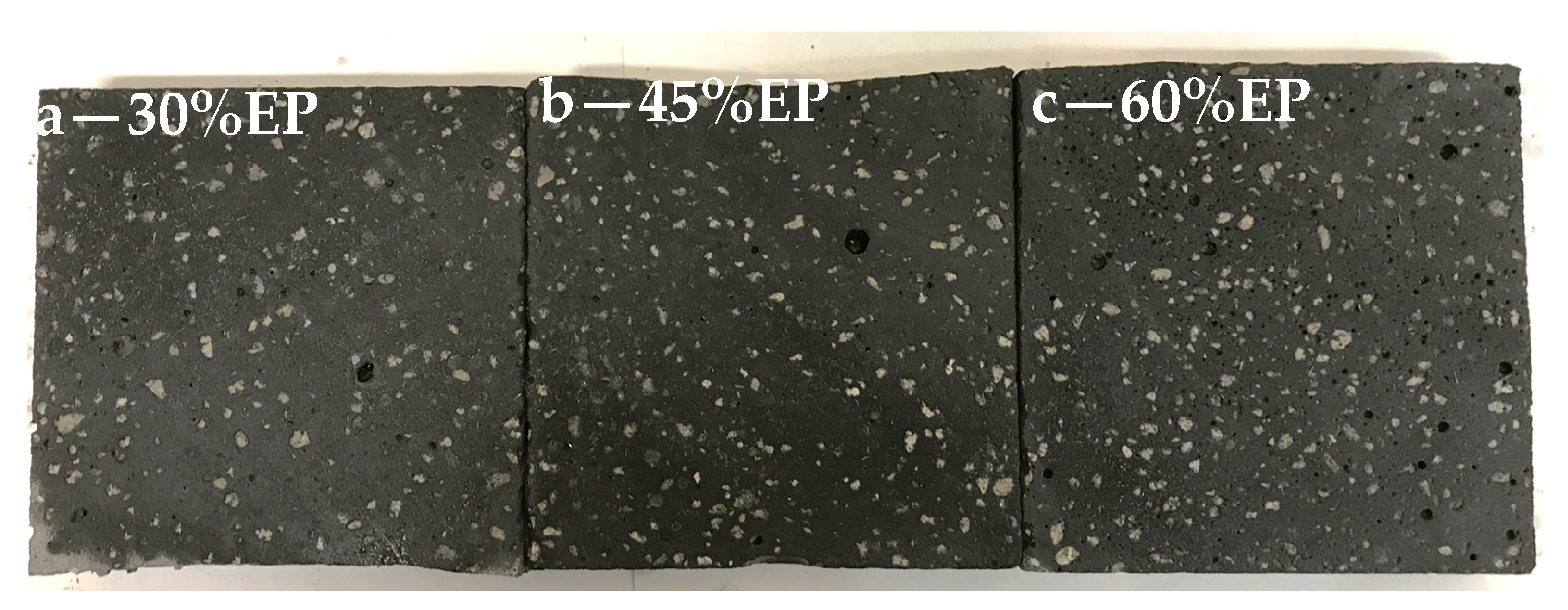
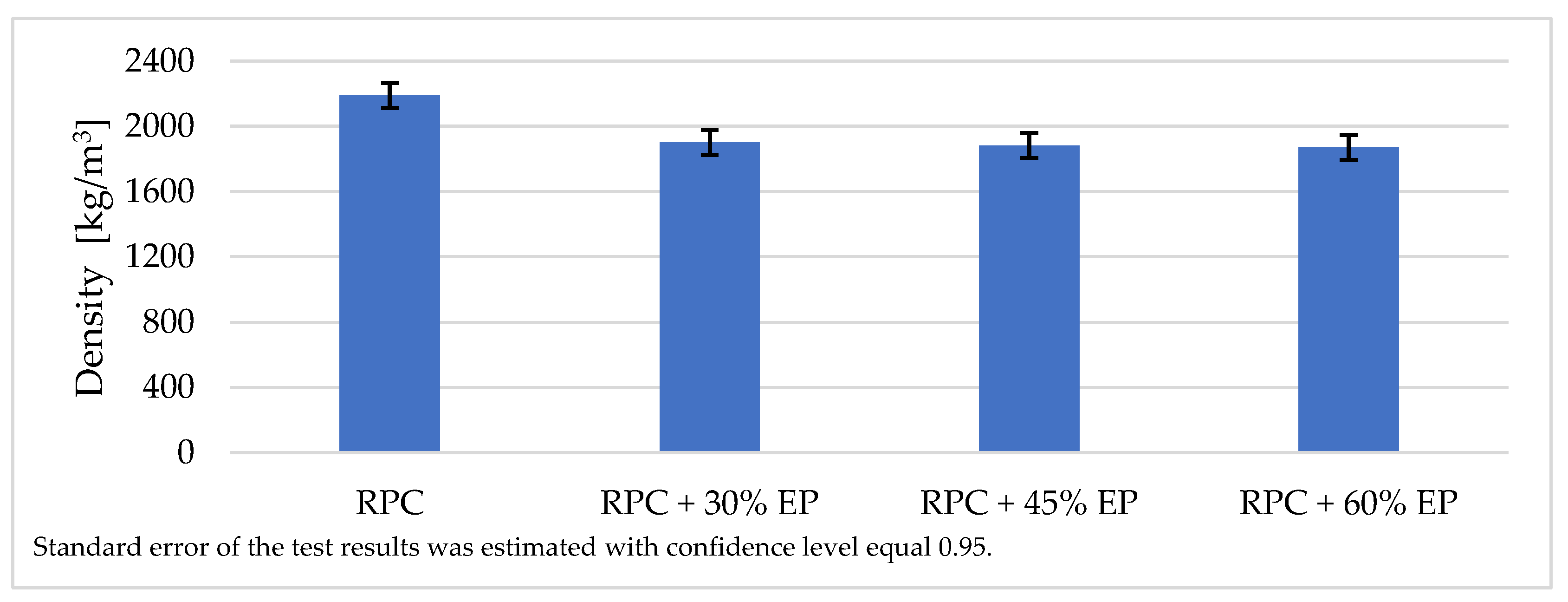
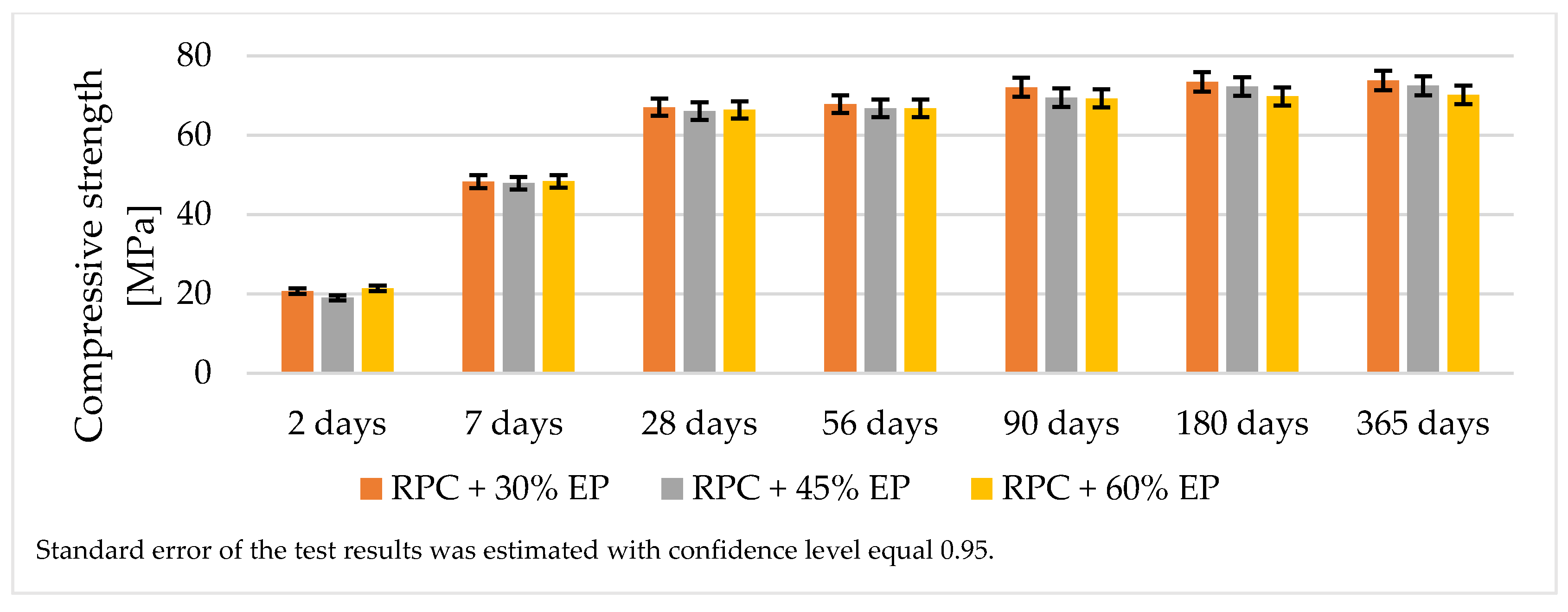

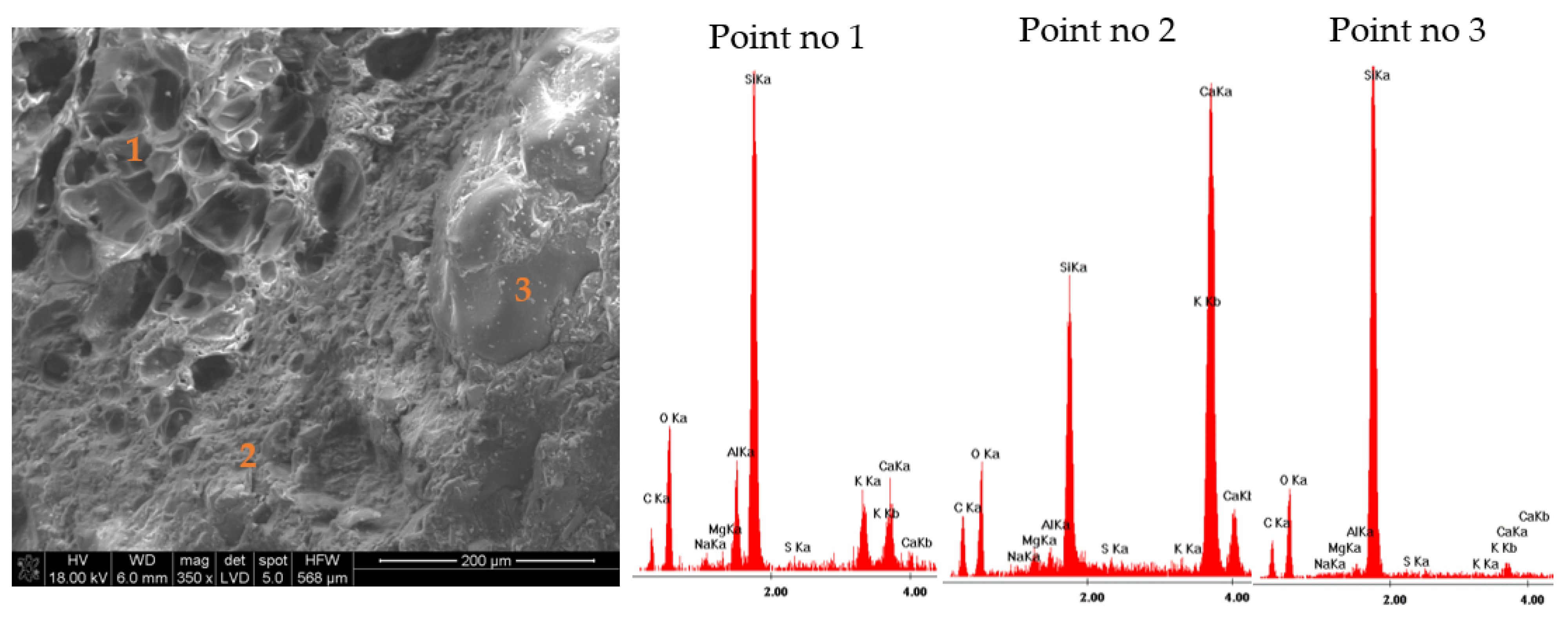
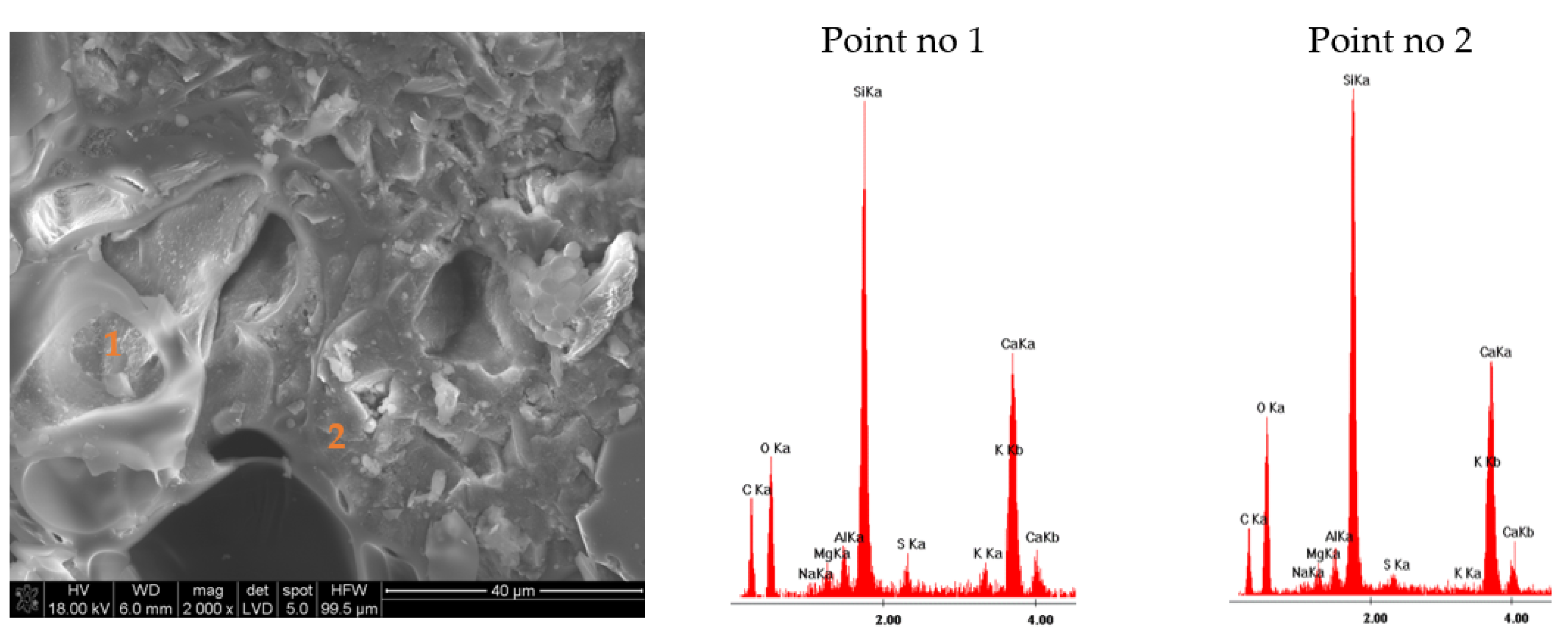
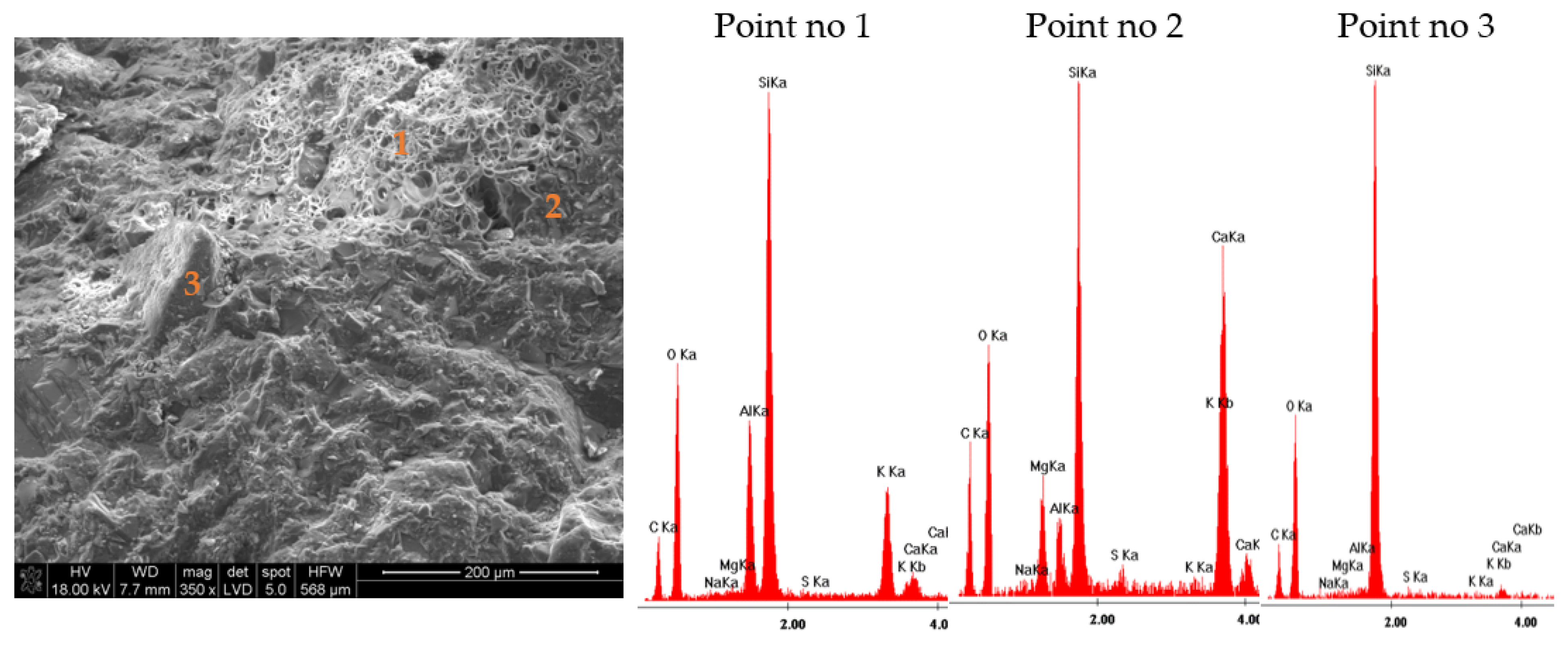

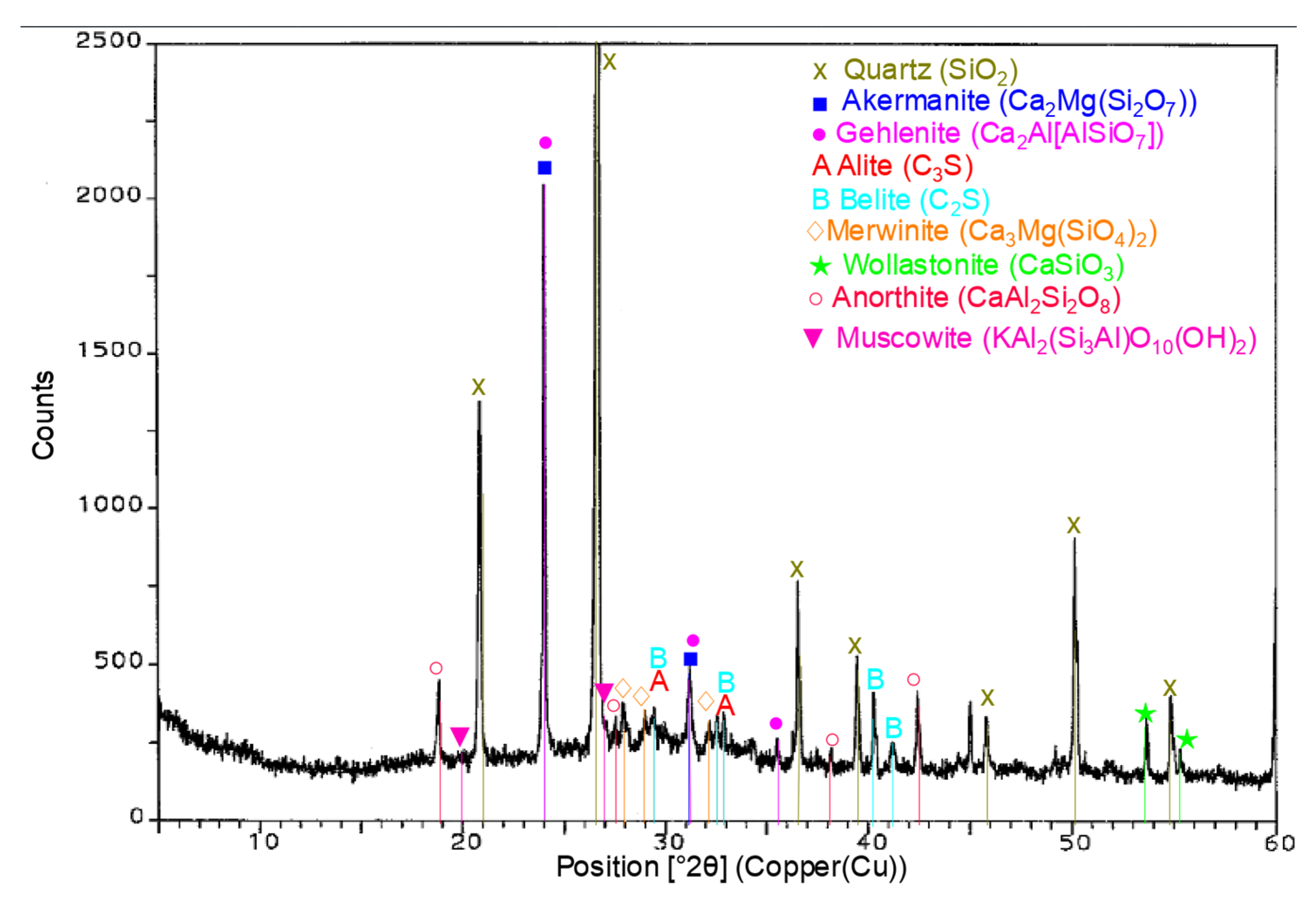

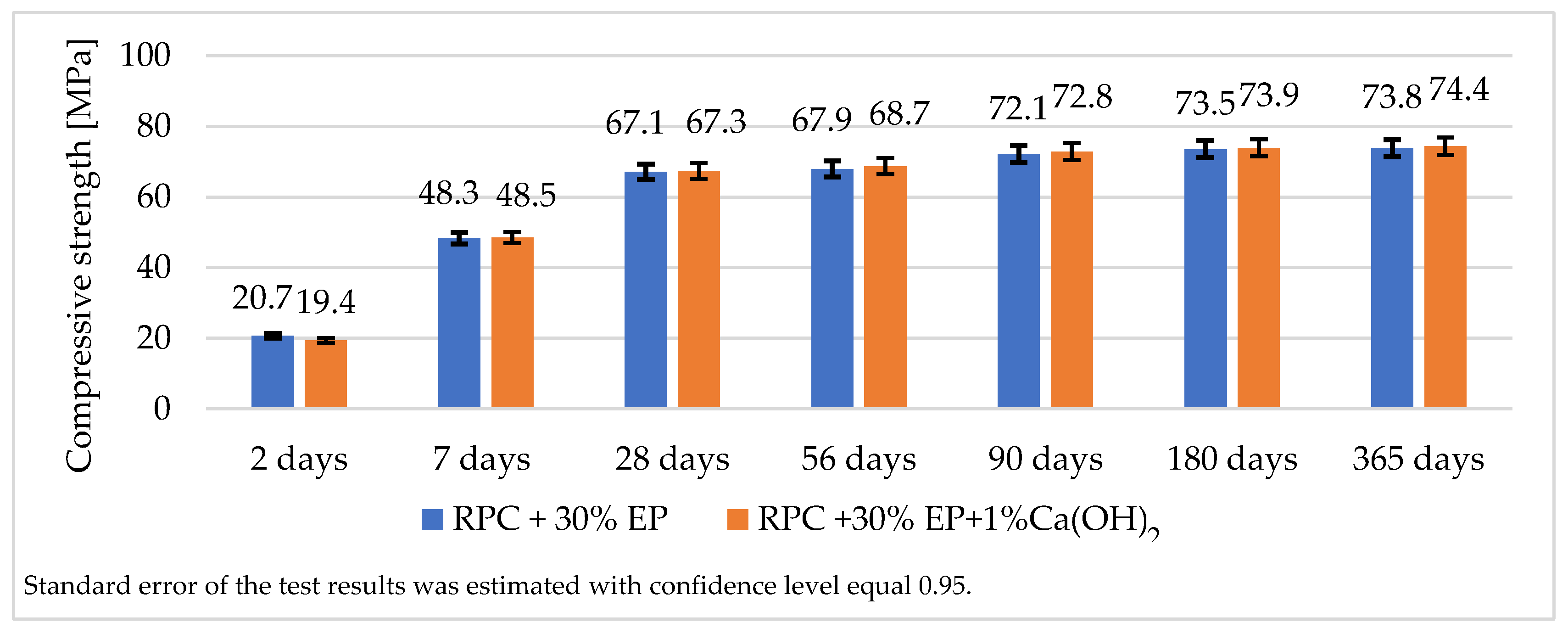

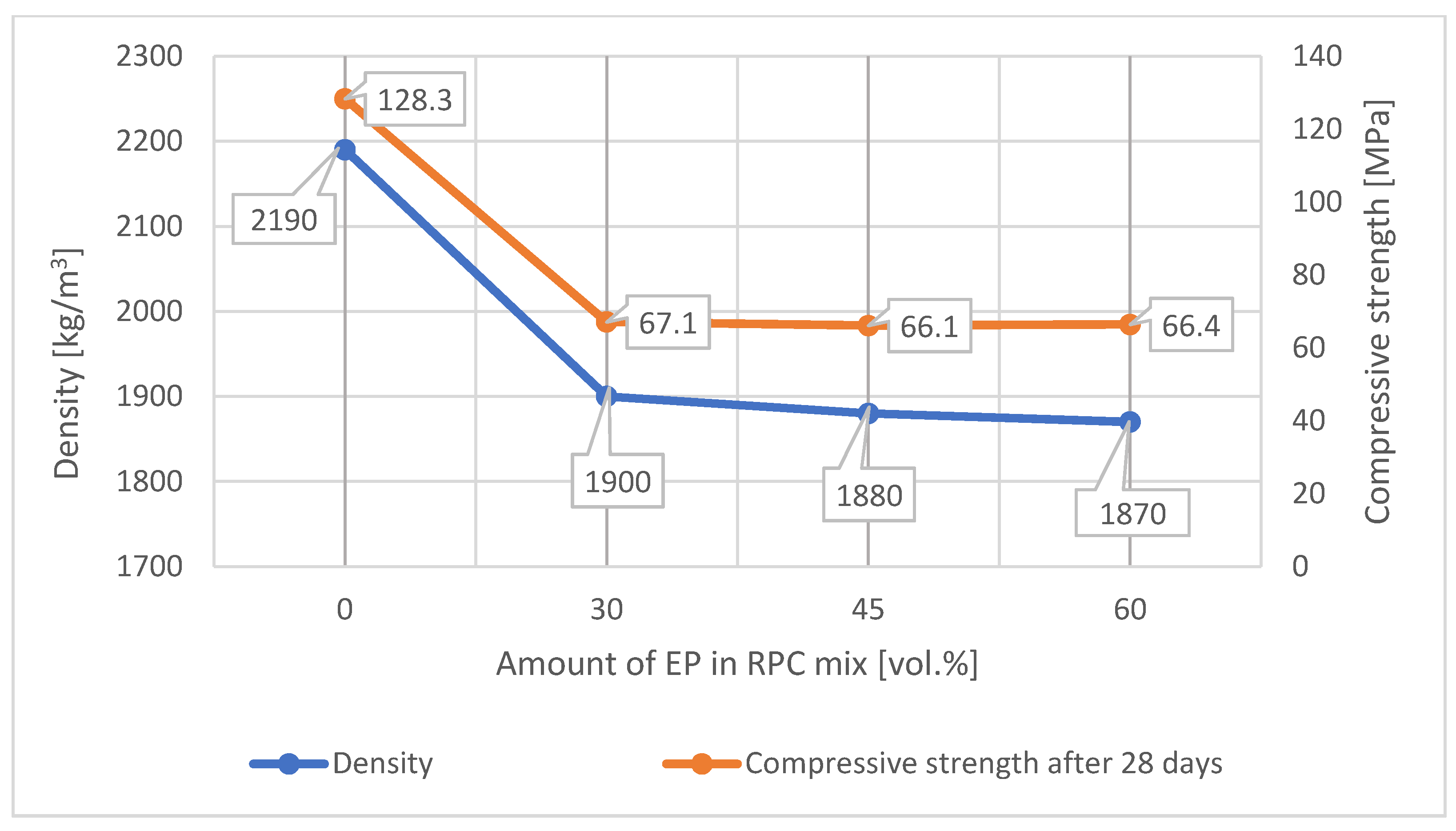
| Percentage Pass [% Mas.] | |||||||
|---|---|---|---|---|---|---|---|
| Sieve size [mm] | 0 | 0.063 | 0.25 | 0.5 | 1.0 | 2.0 | 4.0 |
| Expanded perlite (EP) | 0 | 4 | 17 | 27 | 32 | 48 | 100 |
| Component | Cement | Expanded Perlite (EP) | Waste Silica | Quartz Powder | Quartz Sand | w/c | w/b | SP 1 |
|---|---|---|---|---|---|---|---|---|
| RPC without lightweight aggregate | 850.0 | - | 170.0 | 289.0 | 688 | 0.24 | 0.20 | 3% |
| RPC + 30% EP | 724.0 | 52.8 | 144.8 | 246.0 | 586.4 | 3% | ||
| RPC +45% EP | 707.0 | 78.4 | 141.4 | 240.4 | 572.7 | 4% | ||
| RPC +60% EP | 693.0 | 102.6 | 138.6 | 235.6 | 561.3 | 5% |
| Sample | Loose Bulk Density [kg/m3] | Water Absorption [%] | Crushing Resistance [MPa] |
|---|---|---|---|
| Expanded perlite (EP) | 123.3 | 19.3 | 0.66 |
| Sample | 10 min | 30 min | 60 min |
|---|---|---|---|
| RPC without lightweight aggregate | 220 | 225 | 225 |
| RPC + 30% EP | 175 | 170 | 175 |
| RPC + 45% EP | 130 | 125 | 125 |
| RPC + 60% EP | 115 | 110 | 95 |
| Sample | RPC | RPC + 30% EP | RPC + 45% EP | RPC + 60% EP |
|---|---|---|---|---|
| Water absorption [%] | 3.3 | 3.3 | 3.5 | 3.4 |
| Scaling [kg/m2] | 0.026 | 0.040 | 0.044 | 0.040 |
| Sample | Pozzolanic Activity after 28 Days [%] | Pozzolanic Activity after 90 Days [%] |
|---|---|---|
| Fly ash | 76.7 | 87.2 |
| Silica fume | 91.5 | 95.8 |
| Quartz powder | 71.6 | 75.9 |
| Expanded perlite (EP) | 49.2 | 63.2 |
Publisher’s Note: MDPI stays neutral with regard to jurisdictional claims in published maps and institutional affiliations. |
© 2021 by the authors. Licensee MDPI, Basel, Switzerland. This article is an open access article distributed under the terms and conditions of the Creative Commons Attribution (CC BY) license (https://creativecommons.org/licenses/by/4.0/).
Share and Cite
Grzeszczyk, S.; Janus, G. Lightweight Reactive Powder Concrete Containing Expanded Perlite. Materials 2021, 14, 3341. https://doi.org/10.3390/ma14123341
Grzeszczyk S, Janus G. Lightweight Reactive Powder Concrete Containing Expanded Perlite. Materials. 2021; 14(12):3341. https://doi.org/10.3390/ma14123341
Chicago/Turabian StyleGrzeszczyk, Stefania, and Grzegorz Janus. 2021. "Lightweight Reactive Powder Concrete Containing Expanded Perlite" Materials 14, no. 12: 3341. https://doi.org/10.3390/ma14123341
APA StyleGrzeszczyk, S., & Janus, G. (2021). Lightweight Reactive Powder Concrete Containing Expanded Perlite. Materials, 14(12), 3341. https://doi.org/10.3390/ma14123341






